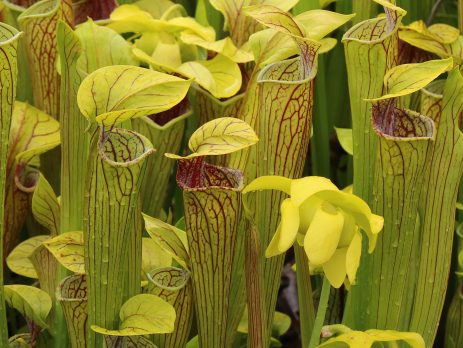What are some interesting facts about sarracenia?
Sarracenia, commonly known as North American pitcher plants or trumpet pitchers, are a fascinating group of carnivorous plants known for their unique adaptations and striking appearance. Here are some interesting facts about Sarracenia:
- Carnivorous Behavior: Sarracenia are carnivorous plants, which means they capture and digest insects and other small prey to supplement their nutrient intake. They have specialized pitcher-shaped leaves that act as traps.
- Pitcher Shape: The leaves of Sarracenia are modified into tubular or pitcher-like structures. These pitchers are often brightly colored and have intricate patterns, attracting insects to their doom.
- Attractive Lures: Sarracenia plants employ various attractive features to lure insects into their traps. These can include nectar-producing glands, vibrant colors, and a sweet scent.
- Fluid-Filled Traps: The inside of the pitcher is filled with a digestive fluid containing enzymes that break down insects and other prey items. This fluid also helps drown and immobilize the trapped prey.
- Lid and Hood: Many Sarracenia species have a lid or hood over the pitcher opening, which helps keep rainwater out and enhances the trap’s effectiveness.
- Bacterial Symbiosis: Some Sarracenia species have a mutualistic relationship with bacteria that help break down the captured prey, making it easier for the plant to absorb nutrients.
- Distribution: Sarracenia are native to North America and are primarily found in southeastern United States, particularly in boggy and wetland areas.
- Species Diversity: There are around 10 recognized species of Sarracenia, with numerous natural and cultivated hybrids. Each species may have slightly different adaptations and appearances.
- Conservation Concerns: Many Sarracenia species are threatened by habitat loss and poaching. Several are listed as endangered or vulnerable, making conservation efforts crucial to their survival.
- Cultivation: Sarracenia are popular among plant enthusiasts and can be cultivated as ornamental plants. They require specific care, including acidic soil, full sun, and adequate water, mimicking their natural habitat.
- Longevity: Sarracenia plants can live for several years, with some specimens in the wild estimated to be over a century old.
- Seasonal Changes: Pitcher plants can undergo seasonal changes in appearance. In winter, the pitchers often die back, but new growth emerges in the spring.
- Hybrid Varieties: Horticulturists and enthusiasts have created numerous hybrid varieties of Sarracenia, resulting in a wide range of colors, shapes, and sizes.
- Legal Protections: Due to their conservation status and vulnerability to overharvesting, some Sarracenia species are protected by law, and it is illegal to collect them from the wild in certain areas.
- Insect-Prey Preferences: Different Sarracenia species have different prey preferences, with some attracting ants, while others are more effective at capturing flies or other insects.
Sarracenia plants are captivating examples of nature’s ingenuity and adaptation to challenging environments. Their unique morphology and carnivorous behavior continue to intrigue botanists, horticulturists, and nature enthusiasts alike.



Leave a Reply
You must be logged in to post a comment.